

Education Support Professionals. For decades, NEA has championed Education Support Professionals (ESPs), their efforts to gain full inclusion in the Association, and their full recognition as accomplished professionals.
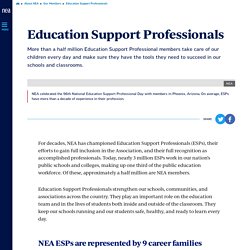
Today, nearly 3 million ESPs work in our nation’s public schools and colleges, making up one third of the public education workforce. Of these, approximately a half million are NEA members. Education Support Professionals strengthen our schools, communities, and associations across the country. 5 Steps to Better School/Community Collaboration. Great examples of school/community partnerships are happening all over the world.

We need more of them, and we need to ensure they are healthy and relevant to the needs of 21st century learners. Throughout my journey setting up the Reinventing School Challenge, I did a significant amount of research to ensure I had a thorough understanding of what existed already, what worked, and what was possible. The more I searched, the themes for successful school transformation emerged: Community/business school partnerships Parental collaboration Curriculum connected to real world experiences Student voice Cross generation learning Locals designing solutions to local problems.
Building Community With Restorative Circles. Restorative circles are most effective when they’re an integral part of school culture. After all, you can’t “restore” a community that you haven’t built or sustained. 7 Steps for Facilitating Meaningful Circles 1. Fostering Belonging With Classroom Norms. Myth vs Fact: High School Internships. How America's public schools keep kids in poverty.
How Restorative Practices Work for Students and Educators. A few Mondays ago, a Denver third-grader named Luca sat down in a circle with his classmates and started a conversation like this: “If you were an animal for a day, based on your mood and feelings today, what animal would it be?”
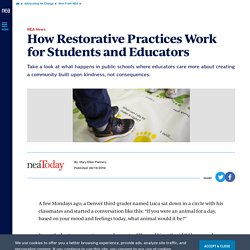
It was the best conversation, say classmates Ellie and Lina. “I said I’d be a monkey because I was feeling silly,” says Ellie. “And I said I’d be a panda!” Says Lina. Partner with Communities In Schools. Resources for Building Community Partnerships. Discover Benefits of Community and Business Partnerships How Can High-Poverty Schools Engage Families and the Community?
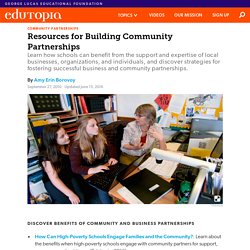
: Learn about the benefits when high-poverty schools engage with community partners for support, resources, and guidance. The NAF Advantage - NAF. The importance of school, community partnerships. I am a firm believer that schools and community are one unit and partnerships with all sectors of the community are essential to helping children reach their maximum potential.
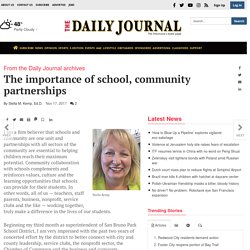
Community collaboration with schools complements and reinforces values, culture and the learning opportunities that schools can provide for their students. In other words, all of us — teachers, staff parents, business, nonprofit, service clubs and the like — working together, truly make a difference in the lives of our students. Beginning my third month as superintendent of San Bruno Park School District, I am very impressed with the past two years of concerted effort by the district to better connect with city and county leadership, service clubs, the nonprofit sector, the Chamber of Commerce and the business and corporate community. The results have been awards and grants, donations, programs, projects and partnerships that are flourishing. The "Why" of Restorative Practices in Spokane Public Schools. What is a Community School? > Home > What is a Community School?
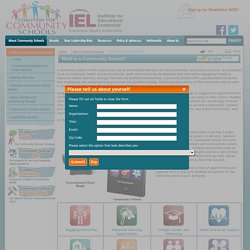
A community school is both a place and a set of partnerships between the school and other community resources. Its integrated focus on academics, health and social services, youth and community development and community engagement leads to improved student learning, stronger families and healthier communities. Community schools offer a personalized curriculum that emphasizes real-world learning and community problem-solving.
Schools become centers of the community and are open to everyone – all day, every day, evenings and weekends. Using public schools as hubs, community schools bring together many partners to offer a range of supports and opportunities to children, youth, families and communities. CNN: Why parents matter in education. Epstein - Six Keys.pdf. New Teachers: Working With Parents. Back-to-School Night 2.0: Supercharge your delivery and find new ways to engage and connect with students’ families using some of these technology suggestions. (Edutopia, 2015) A Checklist for Back-to-School Night: Explore five ideas for the big night: sign-ins on tables, brochures, a classroom constitution, a presentation, and an inviting classroom environment.
(Edutopia, Updated 2015) Back-to-School Night: The Ultimate Conversation Starter for a Successful School Year: Review guidance on how to start the year right by being transparent, direct, and consistent. (Edutopia, Updated 2015) Engaging Parents: An Elementary Teacher's Field Guide: Reflect on what matters most to parents at back-to-school night, and consider ways to engage more deeply. Home Visits Make a School Community Stronger. Teaching - The doctrine of in loco parentis. When minor children are entrusted by parents to a school, the parents delegate to the school certain responsibilities for their children, and the school has certain liabilities.
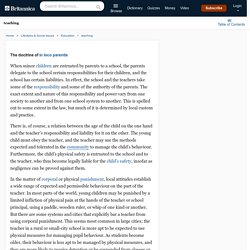
In effect, the school and the teachers take some of the responsibility and some of the authority of the parents. The exact extent and nature of this responsibility and power vary from one society to another and from one school system to another. This is spelled out to some extent in the law, but much of it is determined by local custom and practice. There is, of course, a relation between the age of the child on the one hand and the teacher’s responsibility and liability for it on the other. What is IN LOCO PARENTIS? What does IN LOCO PARENTIS mean? IN LOCO PARENTIS meaning & explanation. 5 Keys to Social and Emotional Learning Success. 25 Ways Teachers Can Integrate Social-Emotional Learning. If there’s anything the past year in education has made painfully obvious, it is the urgency of social-emotional education for our students. Kids need support and instruction to manage successfully in school (whether that’s in person or online) and in life.
Skills like recognizing and managing emotions, being a good friend, controlling impulses, communicating effectively, and working with others are invaluable. Carol Dweck, "Developing a Growth Mindset". CASEL: Overview. Data: 5 Big Challenges in Preparing K-12 Students for the World of Work. Once a month, students at Coxsackie-Athens High School near Albany, N.Y., can have a pizza lunch with local employers, including a national pharmaceutical company and an HVAC organization.
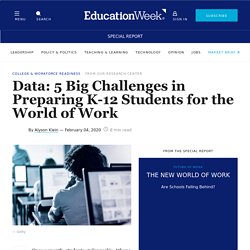
A high school near Detroit that offers students a choice of career specialties recently added a Geographic Information Systems option, so that students can better compete for jobs managing drones and self-driving cars. A middle school in western Massachusetts requires all 7th graders to take a 45-day engineering design course, and all 8th graders to take a similar length “Computing for Innovation” course. Those efforts are a part of a big national push to include much stronger workforce connections in K-12 by revamping curriculum and school culture to help students explore potential careers—including some that their teachers, principals, and district leaders can’t even imagine yet.
Preparing students for the future of work may sound like a no-brainer. Portrait of a Graduate. K-12 Facts - The Center for Education Reform. Updated as of December 2019 Snapshot of U.S.
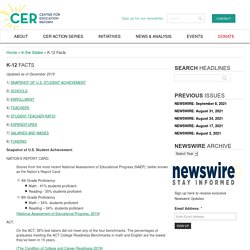
Student Achievement: Scores from the most recent National Assessment of Educational Progress (NAEP), better known as the Nation’s Report Card: Mapping the Digital Divide. Rethinking Learning: The 21st Century Learner. Social-Emotional Learning: What It Is and Why It Matters. The Fixed, Growth and Benefit Mindset. How Do You Define 21st-Century Learning? The term “21st-century skills” is generally used to refer to certain core competencies such as collaboration, digital literacy, critical thinking, and problem-solving that advocates believe schools need to teach to help students thrive in today’s world.

In a broader sense, however, the idea of what learning in the 21st century should look like is open to interpretation—and controversy. To get a sense of how views on the subject align—and differ—we recently asked a range of education experts to define 21st-century learning from their own perspectives. How To Help Every Child Fulfil Their Potential. What are the 4Cs?